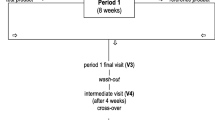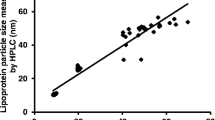Abstract
The effects of the administration of slow-release bezafibrate to hypercholesterolaemic patients who were already receiving long-term probucol treatment (mean 865 days, 500–1000 mg·day−1) were investigated. Bezafibrate was administered at either 200 mg·day−1 (13 males, 13 females, mean age 55.2 years) or 400 mg·day−1 (11 males, 14 females, mean age 57.2 years), and blood was taken at 0, 3, 6 and 12 months after the beginning of combination therapy. Overall, serum total cholesterol (TC), triglyceride (TG), very low density lipoprotein (VLDL)-TC, high-density lipoprotein (HDL)-TG, VLDL-TG, VLDL-phospholipid (PL), lipoprotein (a) [Lp(a)], apolipoprotein (apo) C-III, apo E levels and LCAT activity decreased significantly with this combination therapy, while HDL cholesterol (C), HDL3-C, HDL-PL, apo A-I and apo A-II levels significantly increased, as assessed by analysis of variance (ANOVA). Five patients (one receiving 200 mg·day−1, four receiving 400 mg·day−1 bezafibrate) showed drastic reductions in HDL-C (HDL-C levels were reduced by a mean of 46.2%, 59.3% and 61.6% at 3, 6 and 12 months, respectively) after beginning combination therapy. These HDL-C reductions were maintained for the 1 year of combination therapy, but then returned to pre-combination treatment levels 1 month after discontinuation of bezafibrate. Serum probucol concentrations and cholesteryl ester transfer protein (CETP) mass were assayed at 6 months, and the probucol concentration was higher in the HDL-deficient group (56.2 vs 26.5 μg/ml). In contrast, CETP mass was significantly lower in HDL-deficient patients than in non-HDL-deficient patients (2.08 vs 2.87 mg·l−1). When the patients in the non-HDL-deficient group were divided into two groups, receiving low (200 mg·day−1, n−25) and high (400 mg·day−1, n−21) doses of bezafibrate, the former group showed a significant increase in probucol-lowered HDL-C and apo A-I, although these levels did not return to pre-probucol treatment levels, while the latter group showed no changes in HDL. These data suggest that the addition of a low dose of bezafibrate to probucol tended to reverse probucol-induced HDL lowering, while 9.8% (5 of 51 patients) of the patients exhibited a severe HDL deficiency. Since it is unclear whether or not such an extreme HDL reduction is harmful, HDL deficiency should be carefully monitored with this combination therapy.
Similar content being viewed by others
References
Davignon J (1986) Medical management of hyperlipidemia and the role of probucol. Am J Cardiol 57:22H-28H
Witztum JL, Simmons D, Steinberg D, Beltz WF, Weinreb R, Young SG, Lester P, Kelly N, Juliano J (1989) Intensive combination drug therapy of familial hypercholesterolemia with lovastatin, probucol, and colestipol hydrochloride. Circulation 79:16–28
Illingworth DR, Bacon S (1989) Treatment of heterozygous familial hypercholesterolemia with lipid-lowering drugs. Arteriosclerosis 9:121–134
Saku K, Zhang B, Hirata K, Okura Y, Bai H, Liu R, Arakawa K (1993) Combined therapy with probucol and pravastatin in hypercholesterolemia. Eur J Clin Pharmacol 44:535–539
Carew TE, Schwenke GC, Steinberg D (1987) Antiatherogenic effect of probucol unrelated to its hypercholesterolemic effect: evidence that antioxidants in vivo selectively inhibit low density lipoprotein degradation in macrophage-rich fatty streaks and slow the progression of atherosclerosis in Watanabe heritable hyperlipidemic rabbit. Proc Natl Acad Sci USA 84:7725–7729
Kita T, Nagano Y, Yokode M, Ishii K, Kume N, Ooshima A, Yoshida H, Kawai C (1987) Probucol prevents the progression of atherosclerosis in Watanabe heritable hyperlipidemic rabbits, an animal model of familial hypercholesterolemia. Proc Natl Acad Sci USA 84:5928–5931
Saku K, Sasaki J, Arakawa K (1989) Effects of slow-release bezafibrate on serum lipids, lipoproteins, apolipoproteins and postheparin lipolytic activities in patients with type IV and type V hypertriglyceridemia. Clin Ther 11:331–340
Stewart JM, Packard CJ, Lorimer AR, Boag DE, Shepherd J (1982) Effects of bezafibrate on receptor-mediated and receptor-independent low density lipoprotein catabolism in type II hyperlipoproteinaemic subjects. Atherosclerosis 44:355–365
Vessby B, Lithell H, Ledermann H (1982) Elevated lipoprotein lipase activity in skeletal muscle tissue during treatment of hypertriglyceridaemic patients with bezafibrate. Atherosclerosis 44:113–118
Five-year Study by a Group of Physicians of the Newcastle upon Tyne Region (1971) Trial of clofibrate in the treatment of ischemic heart disease. BMJ 25:767–775
Heller F, Harvengt C (1983) Effect of clofibrate, bezafibrate, fenofibrate and probucol on plasma lipolytic enzymes in normolipidaemic subjects. Eur J Clin Pharmacol 25:57–63
Lipid Research Clinics Program (1984) The lipid research clinics coronary primary prevention trial results. I. Reduction in incidence of coronary heart disease. JAMA 251:351–364
Lipid Research Clinics Program (1984) The lipid research clinics coronary primary prevention trial results. II. The relationship of reduction of incidence of coronary heart disease to cholesterol lowering. JAMA 251:365–374
Levy RI, Brensike JF, Epstein SE, Kelsey SF, Passamani ER, Richardson JM, Loh IK, Stone NJ, Aldrich RF, Fisher ML, Battaglini JW, Moriarty DJ, Friedewald FL, Detre KM (1984) The influence of changes in lipid values induced by cholestyramine and diet on progression of coronary artery disease: results of the NHLBI type II coronary intervention study. Circulation 69:325–337
Franceschini G, Sirtori M, Vaccarino V, Gianfranceschi G, Rezzonico L, Chiesa G, Sirtori CR (1989) Mechanisms of HDL reduction after probucol changes in HDL subfractions and increased reverse cholesteryl ester transfer. Arteriosclerosis 9:462–469
Yamamoto A, Matsuzawa Y, Yokoyama S, Funahashi I, Yamamura T, Kishino B (1986) Effects of probucol on xanthomata regression in familial hypercholesterolemia. Am J Cardiol 57:29H-35H
Havel RJ, Eder HA. Bragdon JH (1955) The distribution and chemical composition of ultracentrifugally separated lipoproteins in human serum. J Clin Invest 34:1345–1353
Allain CC, Poon LS, Chan CS, Richmond W, Fu PC (1974) Enzymatic determination of total serum cholesterol. Clin Chem 20:470–475
Eggstein M, Kreutz FH (1966) Eine neue Bestimmung der Neutralfette in Blutserum und Gewebe. I. Mit Prinzip, Durchführung und Besprechung de Methode. Wien Klin Wochenschr 44:262
Noma A, Nezu-Nakayama K, Kita M, Okabe H (1978) Simultaneous determination of serum cholesterol in high- and low-density lipoproteins with use of heparin Ca2+, and an anionexchange resin. Clin Chem 24:1504–1508
Ikeda T, Shibuya Y, Senba U, Sugiuchi H, Araki S, Uji Y, Okabe H (1991) Automated immunoturbidimetric analysis of six plasma apolipoproteins: correlation with radial immunodiffusion assays. J Clin Lab Anal 5:90–95
Ishitoya Y, Sato K (1979) Clinical significance of lecithin acyltransferase in plasma. Jpn J Clin Pathol 26:1050–1054.
Abe A, Noma A (1988) Enzyme-linked immunosorbent assay of lipoprotein (a) in serum and cord blood. Clin Chim Acta 177:31–40
McPherson R, Hogue M, Milne RW, Tall AR, Marcel YL (1991) Increase in plasma cholesteryl ester transfer protein during probucol treatment. Arteriosclerosis 11:476–481
Nagano Y, Kita T, Yokode M, Ishii K, Kume N, Otani H, Arai H, Kawai C (1989) Probucol does not affect lipoprotein metabolism in macrophages of Watanabe heritable hyperlipidemic rabbits. Arteriosclerosis 9:453–461
Ying H, Saku K, Harada R, Takami N, Sasaki N, Saito Y, Arakawa K (1990) Putative mechanisms of action of probucol on high-density lipoprotein apolipoprotein A-I and its isoprotein kinetics in rabbits. Biochim Biophys Acta 1047:247–254
Nestel PJ, Billington T (1981) Effects of probucol on low density lipoprotein removal and high density lipoprotein synthesis. Atherosclerosis 38:203–209
Atmeh RF, Stewart JM, Boag DE, Packard CJ, Lorimer AR, Shepherd J (1983) The hypolipidemic action of probucol: a study of its effect on high and low density lipoproteins. J Lipid Res 24:588–595
Yokoyama S, Yamamoto A, Kurasawa T (1988) A little more information about aggravation of probucol-induced HDL-reduction by clofibrate. Atherosclerosis 70:179–181
Dahlen GH, Guyton JR, Attar M, Farmer JA, Kautz JA, Gotto AM Jr (1986) Association of levels of lipoprotein Lp(a), plasma lipids, and other lipoproteins with coronary artery disease documented by angiography. Circulation 74:758–765
MBewu AD, Durrington PN (1990) Lipoprotein (a): structure, properties and possible involvement in thrombogenesis and atherogenesis. Atherosclerosis 85:1–14
Maeda S, Okuno M, Abe A, Noma A (1989) Lack of effect of probucol on serum lipoprotein (a) levels. Atherosclerosis 79:267–269
Barbir M, Hunt B, Kushwaha S, Kehely A, Prescot R, Thompson GR, Mitchell A, Yacoub M (1992) Maxepa versus bezafibrate in hyperlipidemic cardiac transplant recipients. Am J Cardiol 70:1596–1601
Maggi FM, Biasi GM, Catapano AL (1993) Reduction of Lp(a) plasma levels by bezafibrate. Atherosclerosis 100:127–128
Author information
Authors and Affiliations
Rights and permissions
About this article
Cite this article
Saku, K., Zhang, B., Jimi, S. et al. High-density lipoprotein and apolipoprotein A-I deficiency induced by combination therapy with probucol and bezafibrate. Eur J Clin Pharmacol 48, 209–215 (1995). https://doi.org/10.1007/BF00198300
Received:
Accepted:
Issue Date:
DOI: https://doi.org/10.1007/BF00198300




